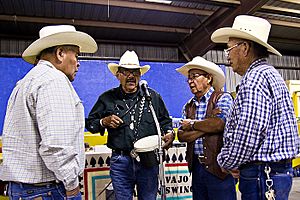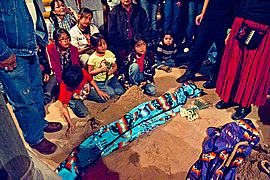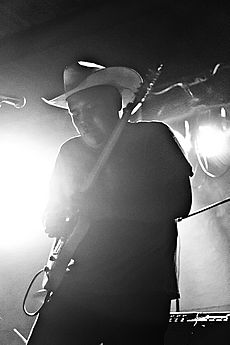Navajo music facts for kids
Navajo music is the special sounds and songs made by the Navajos. Most Navajo people live in the Four Corners area of the Southwestern United States, in a place called the Navajo Nation.
Long ago, Navajo music was mostly ceremonial chants. These songs often told stories from Diné Bahaneʼ, which are the Navajo creation stories. Today, Navajo music includes many different styles. You can hear everything from country music to rock and rap. These songs are sung in both English and the Navajo language.
Contents
Traditional Navajo music is always sung. People use instruments like drums, rattles, and flutes to go along with the singing. These instruments help to make the music even more special.
Many years ago, there were over 1,000 'Medicine People' among the Navajo. These people were skilled in performing many ceremonies and prayers. Their goal was to bring back hózhǫ́. This word means 'harmony', 'beauty', good health, peace, and balance.
Some Navajo songs are very sacred and holy. These are like classical music for the Navajo people. They are part of a deep spiritual tradition. Other songs are more like popular music. These include songs for personal use, patriotic songs, work songs, and songs for fun. The sacred songs are only sung during ceremonies to keep them special. Popular songs can be performed in public.
The longest Navajo ceremonies can last up to ten days and nights. During these ceremonies, people perform rituals to bring back balance between good and evil. A hataałii (a ceremonial singer), uses sandpaintings or masked yéʼii bicheii (holy people). They also use other special tools. They chant sacred songs to ask for help from Navajo gods and nature. This helps to bring a person back into harmony with the world. In ceremonies with sandpaintings, the person needing help sits on the sandpainting. This connects them to the gods and stories of the Diné Bahaneʼ.
The words to these songs can last over an hour. They are usually sung in groups. The lyrics tell long stories, like epic poems. They talk about how the world began, how things work, and important lessons about life. Longer songs are split into two or four balanced parts. They often switch between chant-like verses and lively melodic choruses.
The lyrics often tell stories that repeat in cycles. For example, Changing Woman is a very important figure in Navajo traditions. She is born in spring, grows up in summer, becomes an adult in autumn, and an old lady in winter. Then, the cycle starts again. Her sons, the Hero Twins, Monster Slayer and Born-for-the-Water, are also sung about. They bravely got rid of giants and evil monsters from the world. These kinds of stories are shared during the sacred ceremonies.
The "popular" Navajo music has lively melodies. It often uses wide leaps in sound and covers a range of about an octave. The songs are built from repeating, dividing, and combining short musical phrases. Short songs often follow each other, especially in work songs. The words in these songs are mostly vocables (sounds without a clear meaning). Some vocables are special to certain types of music. But these songs can also have short, funny, or playful words.
Shoegame Songs
Long ago, the animals on Earth came together to play Késhjééʼ, also known as the Navajo moccasin game. There is a story about how Yéʼiitsoh (Giant) and Owl decided to create this game. This story is passed down orally by the Diné people.
Today, many Navajo families play the Navajo Shoegame. Sometimes, different communities play against each other during the winter. There are also many famous Navajo Shoegame singers. The Nez family from Hunter's Point, Arizona, and Pinedale, New Mexico, are well-known for their singing. Leo Nez Sr. and his son Titus Jay Nez are famous for singing Shoegame songs and attending games. Other notable singers include the late Jimmy Cody, Addison Begay, and Sammie Largo.
Children's Songs
Navajo children's songs are often about animals, like pets and farm animals. Some songs are about family members, chores, games, and other daily activities. A child might learn songs from their mother from a very young age. If a baby cries, the mother might sing to it while it is in a cradleboard. Navajo songs have a good rhythm, which can be very calming for a baby. This shows how important songs are in Navajo culture.
These songs might have been a first step for children to learn songs and prayers. These prayers help protect them from bad things or evil figures in Navajo traditions. Children also learn blessings, like using corn pollen in the early morning.
In children's songs, a short chant usually starts the song. Then comes at least one verse of lyrics, and the song ends with the same chant. All traditional songs include chants; they are not just lyrics. Some types of songs have special chants. However, modern children's songs, like Christmas songs or Navajo versions of nursery rhymes, might only have lyrics. Today, both types of songs can be taught in schools on the reservation. This depends on what the teacher knows and can do.
In earlier times, Navajo children might have sung these songs to themselves while herding sheep. This helped them pass the time. Sheep were, and still are, a big part of Navajo life. Giving a child the job of looking after a whole herd taught them leadership and responsibility. One day, they would likely own their own herd. A child, with time on their hands while the sheep grazed, would sing to fill the quiet.
Peyote Songs
Peyote songs are a type of Native American music. They are often sung as part of the Native American Church. This church came to the northern part of the Navajo Nation around 1936. These songs are usually sung with a rattle and a water drum. They are used in ceremonies as part of a sacred ritual. Peyote songs share some musical styles with Apache music and Plains-Pueblo music.
Recently, Verdell Primeaux, a Sioux musician, and Johnny Mike, a Navajo musician, have made modern versions of peyote songs popular.
Contemporary Popular Music
The Navajo music scene is one of the strongest in Native American music today. In the past, Navajo musicians mostly stuck to traditional music, chants, or flute songs. But today, Navajo bands play many different styles. You can find punk, metal, hip hop, blues, rock, country, and even traditional music.
Successful bands like Blackfire, Ethnic De Generation, Downplay, Mother Earth Blues Band, Aces Wild, Tribal Live, and The Plateros have made younger Navajo generations interested in music again. A great mix of old and new can be found in Tribe II Entertainment. This rap duo from Arizona, made up of Mistic, Rollin, Lil' Spade, and Shade, can rap entirely in their native Navajo language. Their popularity and ability to sing in two languages show how rich the Navajo music scene is.
In recent years, the Navajo metal music scene has been growing. This growing metal scene is talked about in the book, Rez Metal: Inside the Navajo Nation Heavy Metal Scene (2020).




